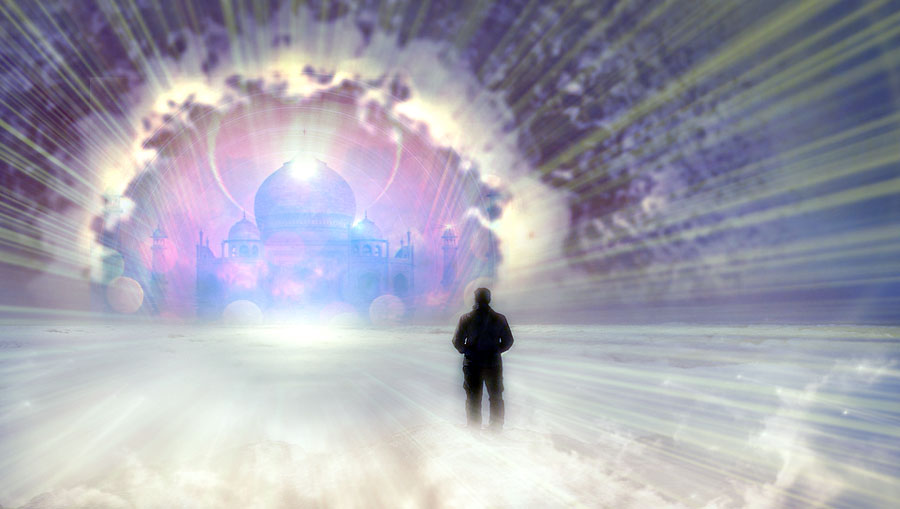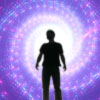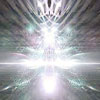Life In The Afterlife
 by Stafford Betty
by Stafford Betty
“The day will assuredly come when our two worlds will be closely interrelated, when communication between the two will be a commonplace of life, and then the great wealth of resources of the spirit world will be open to the earth world, to draw upon for the benefit of the whole human race.” – Monsignor Robert Hugh Benson
Robert Hugh Benson, the communicator of this work, was born in 1871 the son of Edward White Benson, the Archbishop of Canterbury. The younger Benson was ordained to the Anglican priesthood in 1901, but converted to Roman Catholicism three years later. In 1911 he became privy chamberlain to Pope St. Pius X and managed the pope’s household and appointments. He was solidly identified with the Catholic world.
During his short life – he died in 1914 – he became famous in England and America for several novels, especially The Necromancers (1909), in which he ridiculed and condemned spirit communication as ‘dealings with the devil.’ After his death he would be haunted by a need to atone for the mistake he made in this novel. It was not until much later, however, that he was permitted by his spirit advisors to correct it. Life in the World Unseen, first published in 1954, is now in its thirteenth printing. In this book Benson, speaking through the medium Anthony Borgia, tells us he was psychically gifted while functioning as a Catholic priest, but was taught by the Church to think of the gift as a “mental aberration”. He confesses: “To have followed my own inclinations would have entailed a complete upheaval in my life, a renunciation of orthodoxy, and most probably a great material sacrifice, since I had established a second reputation as a writer. … The truth was within my grasp, and I let it fall.” His regret would launch one of his tasks after passing: “What I wanted was to try to undo something that I wished I had never done. … What I had written I could never unwrite, but I could ease my mind by telling the truth, as I now know it, to those who were still on the earth-plane.”
Anthony Borgia was a clairaudient medium: he heard a voice, inaudible to anyone else, that identified itself as coming from Benson. Monsignor Benson had known Borgia when Borgia was only a child. Borgia was only thirteen when Benson died, but Borgia always remembered the older man’s attentions with affection and reverence. Life in the World Unseen was one of several books clairaudiently dictated by Benson. Borgia died in 1989 at the age of 93.
Besides his desire to set the record straight regarding spirit communication, Benson had two other motives for communicating. First, he wanted to show that the doctrines and scriptures of Christianity, and of all other religions, were, in spite of their pretensions, wholly man-made and often dead wrong. After having passed,
“I could see volumes of orthodox teachings, creeds, and doctrines melting away because they are of no account, because they are not true, an because they have no application whatever to the eternal world of spirit and to the great Creator and Upholder of it. I could see clearly now what I had seen but hazily before, that orthodoxy is man-made, but that the universe is God-given.”
Feasts like Epiphany (the three wise men’s visit to the baby Jesus) and Pentecost (the Holy Spirit’s descent upon the Apostles) “have very little moment” here. Only Christmas and Easter are widely celebrated, but they are reinterpreted. They are timed to synchronize with earth’s celebrations, but they apply to everybody, not only to Jesus: “Both Christmas and Easter are looked upon as birthdays: the first, a birth into the earth world; the second, a birth into the spirit world.”
His second motive was to remove a near-universal misapprehension among Christians concerning the actual nature of the afterlife. Near the end of his book he writes: “I hope that, by now, I have sufficiently indicated that the spirit world is not a land of idleness, not a land where its inhabitants spend the whole of their lives in a super-ecstatic atmosphere of religious exercises, formally offering up ‘prayer and praise’ to the Great Throne in a never-ceasing flow.” The world he describes is a diviner world than ours by far, but it is also a world we would feel at home in. This is the world we will be looking at here.
Of all after death accounts I’ve read, this one goes into the greatest detail about what I might call the physics of the world to come. One chapter is devoted to time and space as they are perceived by spirits. Another deals with the geographical position of the spirit world relative to earth. After telling us that the earth world and the spirit world “interpenetrate one another”, and that the “low realms of darkness are situated close to the earth-plane”, Benson explains more fully: “With the spirit world made up of a series of concentric circles, having the earth world approximately at the center, we find that the spheres are subdivided laterally to correspond broadly with the various nations of the earth, each subdivision being situated immediately over its kindred nation.”
Another section of the book is devoted to the flowers of the spirit world, still another to the soil. Yes, the soil! The following paragraph is typical:
“To obtain an adequate idea of the ground upon which we walk and on which our houses and buildings are erected, you must clear your mind of all mundane conceptions. First of all, we have no roads as they are known on earth. We have broad extensive thoroughfares in our cities and elsewhere, but they are not paved with a composite substance to give them hardness and durability for the passage of a constant stream of traffic. We have no traffic, and our roads are covered with the thickest and greenest grass, as soft to the feet as a bed of fresh moss. It is on these that we walk. The grass never grows beyond the condition of being well-trimmed, and yet is is living grass. It is always retained at the same serviceable level, perfect to walk upon and perfect in appearance.”
Benson tells us there are many ‘realms’ or ‘spheres’ within the spirit world. He lives in a happy realm, a kind of paradise of forests and meadows, of seas and lakes, of warm breezes and lovely birdsong, of cloudless clear light emanating from the central sun. Many inhabitants are homeless, for homes are not needed: there are no thieves or bad weather in Benson’s realm. Nevertheless, many spirits choose out of habit to live in houses dotting the countryside, while others cluster together in cities. Benson takes us to the seashore at one point:
“The view was simply magnificent. Never had I expected to behold a sea. Its coloring was the most perfect reflection of the blue of the sky above, but in addition it reflected a myriad rainbow tints in every little wavelet. The surface of the water was calm, but this calmness by no means implies that the water was lifeless. There is no such thing as lifeless or stagnant water here. From where we were, I could see islands of some considerable size in the distance – islands that looked most attractive and must certainly be visited! Beneath us was a fine stretch of beach upon which we could see people seated on the water’s edge – but there was no suggestion of overcrowding! And floating upon this superb sea, some close at hand – others standing a little way out, were the most beautiful boats.”
He also found splendid cities in the spirit world. He describes one of them:
“As we approached the city, it was possible for us to gather some idea of its extensive proportions. It was, I hardly need to say, totally unlike anything I had yet seen. It consisted of a large number of stately buildings each of which was surrounded with magnificent gardens and trees, with here and there pools of glittering water, clear as crystal. … Here we find broad thoroughfares of emerald green lawns in perfect cultivation, radiating, like the spokes of a wheel, from a central building which, as we could see, was the hub of the whole city. There was a great shaft of pure light descending upon the dome of this building, and we felt instinctively … that in this temple we could together send up our thanks to the Great Source of all.”
But there were more important things to do than sight-see. Learning is a passion for Benson, for the pursuit of truth leads to progress upward into higher worlds and thus greater happiness. Learning meant, for Benson, spending a lot of time in the city’s immense ‘hall of literature’. This library was unlike earth’s in more ways than its size. He explains:
“I have dipped into history, and I was amazed when I started to read. … I found that side by side with statements of pure fact of every act by persons of historical note, by statesmen in whose hands was the government of their countries, by kings who were at the head of those same countries, side by side with such statements was the blunt naked truth of each and every motive governing or underlying their numerous acts – the truth beyond disputation. Many of such motives were elevated; many, many of them were utterly base.”
Another way to grow in spirit is by serving others. Benson tells us he governed by a “constant urge to be doing something useful. Something that will be of benefit to others”.
But all is not work. Much of the time work and play are intertwined, as in theatrical productions. Comedies usually center on the predicaments and misadventures of the old earth life: “We can go to see comedies where, I do assure you, the laughter is invariably much more hearty and voluminous than is ever to be heard in a theater of the earth-plane. In the spirit world we can afford to laugh at much that we once, when incarnate, treated with deadly seriousness and earnestness!” Historical pageants are even more interesting, especially when the actors are the very men and women who played those roles back on earth: “But surely the most impressive, and, at the same time, interesting experience is to be present at one of these pageants where the original participants themselves re-enact the events in which they were concerned, first as the events were popularly thought to have occurred, and then as they actually took place.” In still other ways spirit theater is different from ours. For example, “In such pageants the coarser, depraved and debased incidents are omitted entirely, because they would be distasteful to the audience, and, indeed, to all in this realm. Nor are we shown scenes which are, in the main incidents, nothing but battle and bloodshed and violence.”
It is interesting to see what Benson says about the sports of earth. In the spirit world thought controls movement, and the usual effects of gravity can be annulled at will. Therefore “anything in the nature of propelling a ball by striking it would lead to quite hopeless results”. Lest anyone should be saddened at the prospect of there being no baseball or cricket to while away the hours, Benson says, “There is such a superabundant supply of vastly more entertaining things to be seen and done here, beside which a great deal of the earthly recreations appear as sheer trivialities.”
There is a whole chapter on occupations and jobs, others on the arts. Much work as we know it on earth does not exist. In a world in which there is no garbage, no dust, no industrial waste, no heating or cooling, no bodily illness, no way to physically injure oneself or another, and no difficulty getting from one place to another, that is not surprising. There are no cars, no felling of forests, no laundries, no appliances, no emergency rooms, no meds to remember to take, no bomb factories, no banks, and no stock exchanges. Harmony reigns to such an extent that there aren’t even any trial lawyers! Benson mentions a small orchard and even eats one of its delicious fruits, but nothing like agriculture exists. There is an immense amount of teaching, counseling, building, gardening, craftsmanship, and artistic expression. Music is the supreme art form, and craftsmen are needed to make the instruments. Libraries abound, and books have to be printed. Tapestries need to be woven. (Not cloth for clothing, because clothing is part of a spirit’s body.) Cities have to be built. So there are plenty of jobs to do: “All that we have in our halls and our houses, in our homes and in our gardens, has to be made, to be fashioned, or created, and it requires someone to do it. The need is constant, and the supply is constant, and it will ever be so.” In one fascinating chapter he describes in detail how a building is constructed – quite a contrast to the way we do it! The only rule concerning occupations in the spirit world is that you don’t have to do a job you dislike because you need the money.
In perhaps the most surprising pages of the book, Benson tells us that sound and light are intimately connected in the spirit world – so much so that, as he puts it, “all music is color, and all color is music. The one is never existent without the other. That is why the flowers give forth such pleasant tones when they are approached. … The water that sparkles and flashes colors is also creating musical sounds of purity and beauty.” Since light and sound are always found together, is it possible to control light in the process of making music? It is, and “musical architecture” is the result. We see an example of this in an open-air concert that Benson attended: “The musical sounds sent up by the orchestra were creating, up above their heads, this immense musical thought-form, and the shape and perfection of this form rested entirely upon the purity of the musical sounds [and] the purity of the harmonies.”
A composer, we are told, “can build a majestic form as grand as a Gothic cathedral”. Benson was tremendously excited by the experience: “Unlike the earth where music can only be heard, there we had both heard and seen it.”
You might think there is no place for science in the spirit world, but this is not so. Scientists are plentiful, and much of their time is spent trying to understand better the incredibly complex laws of their own new world. Others seek to transmit (telepathically) to earth the discoveries they have made that will help it. Benson claims that “the earth world has the spirit world to thank for all the major scientific discoveries that have been made throughout the centuries.” In fact the spirit world is far ahead of earth, so far that certain discoveries are withheld until a time that they would not be “misused by unscrupulous people”.
So what is Benson’s occupation? He functions as neither scientist nor artist. Instead he plays the role of the priestly counselor – a role he enjoyed back on earth and enjoys again. But the aim of the counseling is peculiar to the spirit world. He explains:
“The percentage is low, deplorably low, of people who come into the spirit world with any knowledge at all of their new life and of the spirit world in general. All the countless souls without this knowledge have to be taken care of, and helped in their difficulties and perplexities. That is the principal work upon which Edwin, Ruth [his closest friends] and I are engaged. It is a type of work that appeals to many of the ministers of the church of whatever denomination. Their experience upon earth stands them in good stead, and all of them – perhaps I should say all of us! – know that we are now members of one ministry, with one purpose, serving one cause, and all of us possessed of the same knowledge of the truth of spirit life, without creed, without doctrine or dogma, a united body of workers, men and women.”
One of the most respected occupations is that of the spirit guide; each of us on earth has one or more, and they are often behind the subtle promptings to virtue that we sometimes act on. This is what Benson says about this class of spirit.
“Spirit guides constitute one of the grandest orders in the whole organization and administration of the spirit world. They inhabit a realm of their own, and they have all lived for many centuries in the spirit world. … It would be safe to say that by far the greater number of spirit guides carry on their work all unknown to those whom they serve, and their task is so much the heavier and more difficult. … It naturally saddens them to see the mistakes and follies into which their charges are plunging themselves, and to be obliged to stand aloof because of the thick wall of material impenetrability which they have built up round themselves. … Inspiration, devoted to whatever cause or pursuit, comes from the world of spirit, and from nowhere else.”
Benson goes on to say that without the constant influence of spirit guides
“the earth world, in a very brief time, would be reduced to a state of complete and absolute barbarity and chaos. And the reason is that man thinks he can get along nicely by his own powers and volition. He is conceited enough to think that he requires no help from any source whatever … your world looks very dark to us, and we try very hard to bring a little light to it. We try to make our presence known, our influence felt.”
Many other spirits are engaged in what I’ve called in (in other works) missionary work; out of compassion they feel called to descend into the dark regions of the spirit world, spirit regions very close to earth, and lead lost souls out of their misery.
The missionary spirit must first cross a boundary. On one occasion, under the guidance of an experienced spirit, Benson and his friends walk (they choose to walk rather than teleport) into a country that is desert-like:
“We saw no flowers, no trees, no dwellings, and everywhere seemed bleak and barren. There was no sign of human life, and life seemed to be rapidly disappearing from beneath our feet, as by now the grass had ceased altogether, and we were upon hard ground. We noticed, too, that the temperature had fallen considerably. Gone was all that beautiful genial warmth.”
It would get worse. As they progressed, they eventually came upon the inhabitants of this dark, chilly world – many of them. There would be no devil, as in Dante, and no damnation by a righteous God. Instead,
“We could see, as we walked along, whole bands of seemingly demented souls passing on their way. … Their bodies presented the outward appearance of the most hideous and repulsive malformations and distortions, the absolute reflection of their evil minds. … The multitudinous sounds that we heard were in keeping with the awful surroundings, from mad raucous laughter to the shriek of some soul in torment – torment inflicted by others as bad as himself.”
Eventually they came upon a region whose inhabitants looked subhuman, a place where “all manner of bestialities and grossness, and such barbarities and cruelties as the mind can scarcely contemplate” were seen. One man in particular fascinated them. He showed “not the least sign of regret for his loathsome earthly life … we could not feel one tiny vestige of sympathy for this inhuman monster”. Yet even for him there was hope: … “we could do nothing but hope that one day this dreadful being would call for help in true earnestness and sincerity. His call would be answered – unfailingly”.
If this sounds stark, it is. Benson does not find a God who magically transforms such persons into saints by divine fiat. Benson’s God does not alter human character, because to do that would be the same as destroying one person and replacing him with another. Instead he finds a law of karma at work everywhere, a law of the deed that governs the destiny of every spirit. Benson puts it this way:
“Perspectives and view-points are completely altered when one comes into the spirit world. However mighty we were upon the earth-plane, it is spiritual worth only that takes us to our right place in the spirit world, and it is the deeds of our life, regardless of social position, that at our transition will assign to us our proper abode. Position is forgotten, but deeds and thoughts are the witnesses for or against us, and we become our own judges.”
Not only do people’s deeds, or rather their character molded by those deeds, determine which of the many realms they land in; it determines the very house they are assigned:
“An indispensable prerequisite to the ownership of a spirit home is the right to own it, a right which is gained solely by the kind of life we live when incarnate, or by our spiritual progression after our transition to the spirit world. Once we have earned that right there is nothing to prevent our having such a residence if we should wish for one.”
In the meantime spirits must be content to stay where they belong, almost always somewhere between realms “infinitely better [than theirs] – and others infinitely worse”. And that is as it should be. Benson and his friends, for example, do not envy those more evolved spirits who live in “realms of surpassing beauty” that they can’t reach, but look forward to the time that they “have earned the right to enter, either as visitors or as inhabitants”. As for boundaries between realms, “Each sphere is completely invisible to the inhabitants of the spheres below it, and in this respect, at least, it provides its own boundary”. In other words, just as we cannot see the spirit world all around us because it is too ethereal for our gross senses to pick up, so spirits belonging to lower spheres, such as newcomers like Benson, cannot see more refined spheres that belong to more refined souls.
We have looked at the dark regions where souls stubbornly unrepentant dwell, but what about those regions that are heavenly? Benson devotes a long chapter to “the highest realms”. He tells how he and his friends were invited by one of the great souls residing there for a visit. To get there, they had to pass through many realms, for they “were about to be taken into realms far, far removed from [their] own normal habitation”. Their guides took extraordinary measures to adjust the visitors’ vision “to the extra intensity of light” of the high world they would be entering. I do not have space to describe much of what they saw. Here are Benson’s opening words: “We were in a dominion of unparalleled beauty. There is no imagination upon the earth-plane that can visualize such inexpressible beauty, and I can only give you some meager details of what we saw in the limited terms of the earth-plane.” He goes on to describe
“an unending vista spread before us of more earthly miles than it is possible to contemplate. And all through this wide expanse we could see other magnificent buildings built of still more precious stones – of emerald and amethyst, to name but two, and, far away, what looked like pearl. Each of the different buildings was set amid the most entrancing richness of color and grandeur of form. Wherever we cast our eyes, there we could see the flashing of jeweled buildings, reflecting back the rays of the central sun, the myriad colors from the flowers, and the scintillations from the waters of the river that flowed before us far away into the distance.”
But it was the people they met that charmed them the most. They “were greeted by the most friendly and gracious beings, who thus added to our welcome. Welcome, indeed, was the overmastering feeling that enveloped us”. Eventually their host explained why they had been invited:
“to show that the inhabitants of such high realms are not shadowy unreal people, but, on the contrary, they are like ourselves, capable of feeling and exhibiting the emotions of their fine natures, capable of human understanding, of human thought, and as easily susceptible to laughter and free-hearted merriment as were we ourselves … and that although it may take countless years of time to reach those realms, yet there is all eternity in which to achieve that end, and that there are unlimited means to help us upon our way.”
The spirit world according to Benson is a place of endless variety spread out in virtually infinite space – with every individual spirit residing in a realm suitable to his or her spiritual maturity.
Excerpt from The Afterlife Unveiled: What The Dead Are Telling Us About Their World
Life In The World Unseen by Anthony Borgia – Full Book Download-(PDF)
wnload-(PDF)
Posted in Life On The Other Sidewith 1 comment.






LOVED reading this!! It was SOO BEAUTIFUL ????THANK U